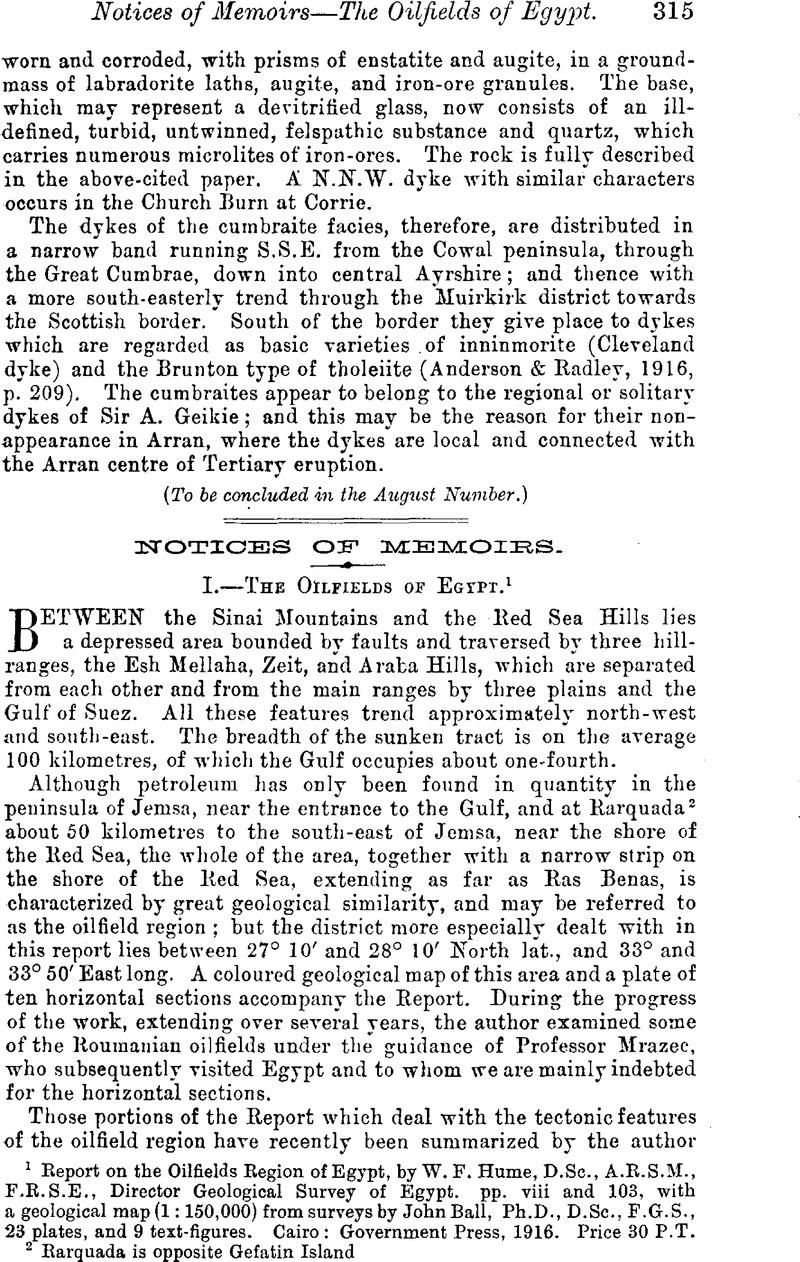No CrossRef data available.
Article contents
Notices of Memoirs
Published online by Cambridge University Press: 01 May 2009
Abstract

- Type
- Notices of Memoirs
- Information
- Copyright
- Copyright © Cambridge University Press 1917
References
page 315 note 1 Report on the Oilfields Region of Egypt, by W. F. Hume, D.Sc., A.R.S.M., F.R.S.E., Director Geological Survey of Egypt. pp. viii and 103, with a geological map (1: 150,000) from surveys by John Ball, Ph.D., D.Sc., F.G.S., 23 plates, and 9 text-figures. Cairo: Government Press, 1916. Price 30 P.T.
page 315 note 2 Rarquada is opposite Gefatin Island.
page 316 note 1 “Some Notes on the Post-Eocene and Post-Miocene Movements in the Oilfield Region of Egypt”: Geol. Mag., 01, 1917, pp. 5–9. The map illustrating this paper should be referred toGoogle Scholar.
page 316 note 2 See review of Dr. Ball's memoir on The Geography and Geology of West-Central Sinai, Geol. Mag., 02, 1917.Google Scholar.
page 318 note 1 Face of the Earth, vol. i, p. 309, English translation.Google Scholar
page 319 note 1 The Topography and Geology of the District between Cairo and Suez, Cairo, 1907, p. 55.Google Scholar.
page 319 note 2 See Geol. Mag., 02, 1917, p. 83.Google Scholar.
page 320 note 1 Explanatory notes to accompany the geological map of Egypt.
page 321 note 1 Bull. Soc. Géol. France, ser. III, vol. vii, p. 741, 1879.Google Scholar.
page 321 note 2 Bull. Soc. Géol. Normandie, 1880.
page 321 note 3 Assoc. Française-Cherbourg, 1905, published 1906, pp. 358–70.Google Scholar.
page 321 note 4 Bull. Soc. Géol. France, ser. iv, vol. iii, p. 258, 1903.Google Scholar.
page 321 note 5 “Niederlande”: Handb. Region. Geol., vol. i, pt. iii, p. 53, 1913.Google Scholar.
page 321 note 6 “Molluskfaunaen I Jyllands Tertiaeraflejringer, etc.”: Mus. Min. Géol. Univ. Copenhague: Paléontologiques, No. 7, 1907 (plates and text).Google Scholar.
page 321 note 7 “Ueber der Schichten der Tertiärformation welche bei Reinbeck durch die Hamburg, etc.”: Amtl. Ber. Deutsch. Nat. Aerz. Kiel (1846), 1847, pp. 232–4.Google Scholar.
page 321 note 8 Die Mollusken-Fauna des Holsteiner Gesteins”: Abhandl. Geb. Nat. Ver. Hamburg, vol. x, No. 8, pp. 14, 1887.Google Scholar.
page 321 note 9 Cat. Syst. Foss. Tert. Mus. Zurich, 1867, pt. ii, p. 13.Google Scholar.
page 322 note 1 Bull. Soc. Géol. France, ser. iv, vol. iii, pp. 256–60, 1903.Google Scholar.
page 322 note 2 “Chronographie Géol.—Text Explicatif”: Comp. Rend. Cong. Géol. Internat. (1894), 1897, p. 597.Google Scholar.
page 323 note 1 Quart. Journ. Geol. Soc., vol. lvi, p. 708, 1900.Google Scholar.
page 323 note 2 Ann. Soc. R. Mal. Belgique, vol. xix, pp. lvi–lxvi, 1884.Google Scholar.
page 323 note 3 Mededeel. Rijks. Delfst., 1915, No. 6, p. 9.Google Scholar.
page 323 note 4 Quart. Journ. Geol. Soc., vol. xxvi, pp. 507–9, 1870.Google Scholar.
page 323 note 5 Geol. Mag., 1899, p. 292.Google Scholar.
page 323 note 6 Quart. Journ. Geol. Soc., vol. xli, pp. 65–73, 1885.Google Scholar.
page 324 note 1 Quart. Journ. Geol. Soc., vol. xlii, pp. 201–14, 1886.Google Scholar.
page 324 note 2 Trans. Roy. Geol. Soc. Cornwall, vol. xii, p. 133, 1898.Google Scholar.
page 324 note 3 Quart. Journ. Geol. Soc., vol. xli, p. 72, 1885.Google Scholar.
page 325 note 1 Géologie de la Belgique, vol. i, p. 261, 1880.Google Scholar.
page 325 note 2 The foraminiferal evidence, also, lends support to the view that the Coralline Crag is of older age than has yet been accepted. According to the Monograph on the Crag Foraminifera by Jones, Burrows, and others (Palæontographical Society, 1897, p. 369) the following species are recorded from the Coralline Crag of Sudbourne: Nummulina planulata, Amphistegina vulgaris, Operculina complanata, and Orbitoides aspera, formerly determined as O. faujasi. These are said to be “derived from earlier beds”, although from a recent examination of the specimens, which are in the Geological Department of the British Museum, they present the appearance of having been found in situ. However, the so-called Nummulina might indicate an Eocene or Oligocene horizon, but the other organisms are characteristically Miocene, especially when it may be stated that in Orbitoides aspera, after careful rubbing down of the horizontal surface on the median plane of the figured example, there is exposed a series of minute chamberlets of squarish or hexagonal outline which can only belong to the Miocene genus Lepidocyclina.




